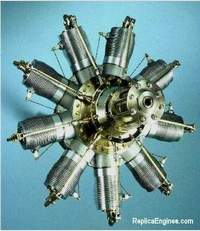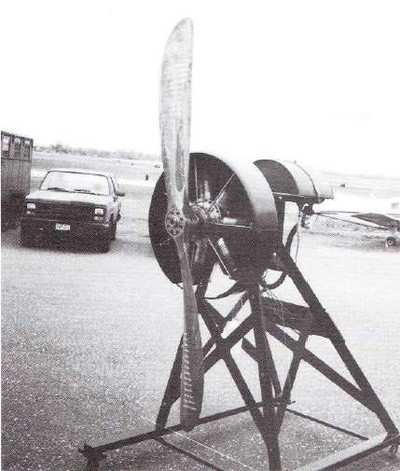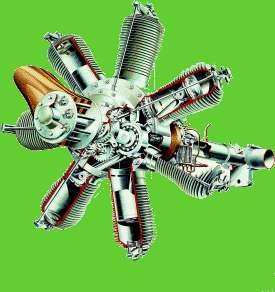 Engine S/N 755 still sounds great
after 90 years of preservation and overhaul
Engine S/N 755 still sounds great
after 90 years of preservation and overhaul
By ANN Contributor John Schmidt
What would you do with an aircraft engine, stored in pristine
condition? Fire it up for public display, of course, even if it is
a very rare rotary engine.
Denny Eggers, president of the Minnesota Air & Space Museum,
intends to do just that with a 1909 Gnome rotary engine at Anoka
County Airport (ANE) in Blaine (MN) on Saturday, June 26th and
Sunday, June 27th (weather permitting). Engine runs are scheduled
for 11 AM, 1 PM and 3PM.
Though it is a round engine, the 1909 vintage Gnome Omega is a
rotary, not a radial. The entire engine spins, as was the design
philosophy of the time. The crank is bolted directly to the
firewall, and the entire engine, prop, case, jugs... everything
acts a bit like a gyroscope, spinning around at engine rpm for
cooling of the cylinders.
The nickel-steel alloy engine features seven cylinders, no
intake or exhaust manifold, no oil, fuel pressure or CHT gauges,
and no gear reduction system. Induction system utilizes the
two-cycle principle, but in operation it is a four-stroke engine.
The original French Chevalier propeller will not be used, so the
Museum is using a Sensenich.

"The engine was carefully packed in grease and lubricated with
castor oil. It was overhauled in 2002. The engine was rebuilt by
Fred Murrin, of Greenville, Penn. He's done some of the engine
rebuilds at Old Rhinebeck, in New York," says Eggers. "It's the
most pristine Gnome engine in the United States."
 ANN was granted an exclusive
interview with the restorer of the engine, Fred Murrin, of
Greenville (PA).
ANN was granted an exclusive
interview with the restorer of the engine, Fred Murrin, of
Greenville (PA).
Fred's phone answering machine identifies him as Red Baron's
Flying Circus, but when you talk with Fred, he claims that it's
just a bit of aviation humor. He is a mechanical engineer who
started to collect rotary engines out of simple curiosity. He now
owns eight of them, including the LeRhone that powers his Fokker
tri-plane. His is one of only three Fokkers in the world that has a
rotary engine. He's flown behind a rotary in that aircraft for more
than 130 hours. Fred's operations are based at Greenville (PA)
airport, 4G1. He hosts his own WWI fly-in every other September at
Wright-Patterson in Ohio.
His interest in rotaries and his mechanical background led to
his rebuilding expertise. This is only the second Gnome rotary
engine Fred has restored. The first belongs to a private aviation
museum collection in California. Fred restores the rotary engines
for the Old Rhinebeck Aerodrome, in New York. He figures he's
restored 20 different types of rotary engines. He is
currently working on an 80 hp LeRhone engine for Peter Jackson,
director of the Lord of the Rings movie trilogy, who, according to
Fred, is quite a WWI aviation buff.
"This one was amazingly complete," Fred claims, referring to the
Minnesota Air and Space Gnome. "It didn't need anything. It's the
most pristine example I've seen. There was a bit of minor corrosion
in the crankcase, but other than that, it was perfectly preserved.
These engines used to be lubricated with castor oil. When the
engine cooled off to room temperature, the castor oil would harden
and preserve the engine."
Fred went on to note, "These engines used to come with a tool
kit specific to Gnome engines. In most rotary engines, parts of the
engine are missing, and the tools are long since lost. This engine
came with spare parts. And, this one not only had the original
tools kit, but also came to me in the original crate with French
markings on it! I wonder how much that crate is worth."
Fred estimates, by examining the amount of carbon in the engine,
that, "this one couldn't have had two hours of running time on it.
If it came from the original 1911 Steco airplane, I wonder if it
ever flew at all. There is no such thing as a 'yellow tag' to this
engine, or any part of it. This was way before there was
certification to engines. I just rebuilt it, and it runs
great."

Some numbers on the Gnome... according to Fred, the compression
ratio of the Gnome rotary was 4:1. It is "about a seven or eight
litre" displacement, and was built to run on 73 octane fuel. "It
should put out about 50 HP at top engine speed of 1200 RPM."
"One interesting thing about this engine is the intake system,"
explained Fred. The air/fuel mixture enters the crankcase, where it
goes up through a valve in the center of the piston. There is no
intake push rod. The valve, in the center of the piston, is only
held shut by a spring. As the piston moves, the pressure of the
crankcase forces the valve open, and the fuel/air mixture enters
through the piston into the combustion chamber." The exhaust is
operated by a single valve in the center of the head.
The exhaust valve is the last step between the hot gas and the
sky. There is no exhaust stack, manifold, or stub. The valve opens,
and the gases are expelled.
Another feature of the Gnome is the fact that the engine
operator must decide on and regulate the fuel/air mixture manually.
Most people are amazed when, before start-up, an operator will take
his finger and manually push open the exhaust valve to put some
fuel in the cylinder to prime the engine.
"Everyone thinks of these engines with modern technology and
practices in mind," says Fred. "Modern day engines have springs
holding the valves shut so firmly that you can't push them open.
The exhaust springs on the Gnome are very light, so light I can
hold it open with my thumb, and people don't know how they stay
closed during a run. Actually, the springs are only there to hold
the exhaust valves shut for starting. Once the engine is running,
centrifugal force takes over, keeping the exhaust valves tightly
closed."
 When asked about the oil system,
Fred states that it is neither a dry nor wet sump system. "The oil
is pushed in through the crank, through the ball bearings -- all
bearings in this engine are ball bearings -- through passageways,
caught by the connecting rods, past the piston skirts, and out the
engine. It's a 'total loss' system. You land, fill up with gas and
oil, and go flying again. The engine on my Fokker was built to lose
one and a third gallons per hour. These are very messy
engines."
When asked about the oil system,
Fred states that it is neither a dry nor wet sump system. "The oil
is pushed in through the crank, through the ball bearings -- all
bearings in this engine are ball bearings -- through passageways,
caught by the connecting rods, past the piston skirts, and out the
engine. It's a 'total loss' system. You land, fill up with gas and
oil, and go flying again. The engine on my Fokker was built to lose
one and a third gallons per hour. These are very messy
engines."
Where does one go to school to learn how to work on these
engines? Last ANN checked, "Gnome and LeRhone 101" were absent from
the course catalogue at Embry-Riddle.
"I don't know," said Fred. "Actually, much of what I know I
learned from common sense, my mechanical training, and actually
working on the engines. These are fairly simple internal combustion
engines. Much of what I read is not correct about these engines.
For example, people who don't know always say that these engines
need overhaul every 20 hours or so. Actually, the castor oil
hardening after disuse is what they're seeing, not overhaul. When
the passages get full of hardened oil, the mechanic simply had to
take the engine apart to clean it and put it back together. I
expect that you could go 200 hours between overhauls on a
properly-cared for engine."
"I've discovered that most of the damage to these engines occurs
when people try to take them apart without the proper tools, and
wreck things using screwdrivers, pry bars, etc.," said Fred. "I
usually use some solvent to break up the congealed castor oil.
That, and a bit of heat from the benzematic torch, and they come
right apart. You have to make your own tools to work on these
engines."
The Smithsonian has a project to record rare sounds, sounds that
one cannot hear anymore, such as the sound of animals on the verge
of extinction, or voices of famous people. Fred thinks he will
encourage them to record the sound of a rotary Gnome to add to the
collection.
"They really sound nice when you hear them run," he adds. "They
aren't loud or obnoxious at all, they make kind of a smooth hissing
sound."
As to the price of the engine, Fred commented that "after WWI,
you could buy one of these for about $30 or $40. They were so cheap
that people bought one just to take it apart and see how it
worked." So, how much can one expect to spend in 2004,
restoring a one-of-a-kind antique aircraft engine?
Dennis Eggers just says, "You won't believe how much the rebuild
cost." This reporter didn't ask if that was unbelievably cheap or
unbelievably expensive, but the engine is significant in
aviation.
 Fred put the engine's place in
aviation history this way: "The Wrights made the first aircraft
engine, for sure, but the Gnome, designed and created by the Seguin
Brothers in France, was more powerful, and was widely used in
Europe for a number of different aircraft designs from aviation's
birth in 1903 into the teens. It's really the engine that got
aviation 'off the ground' in the early days. It was so popular at
one time that it was made by a number of licensees, including
General Vehicle Company of Long Island, NY. The Minnesota Air and
Space Gnome is an original engine from France, though."
Fred put the engine's place in
aviation history this way: "The Wrights made the first aircraft
engine, for sure, but the Gnome, designed and created by the Seguin
Brothers in France, was more powerful, and was widely used in
Europe for a number of different aircraft designs from aviation's
birth in 1903 into the teens. It's really the engine that got
aviation 'off the ground' in the early days. It was so popular at
one time that it was made by a number of licensees, including
General Vehicle Company of Long Island, NY. The Minnesota Air and
Space Gnome is an original engine from France, though."
Hear and see a rare piece of history at Anoka County Airport
(ANE) in Minneapolis (MN) on June 26th or 27th. Suggested donations
are $5, and will go to the Minnesota Air and Space Museum for
funding of their next project, an extremely rare 1911 Steco
aircraft.
 ANN's Daily Aero-Linx (04.15.24)
ANN's Daily Aero-Linx (04.15.24) Classic Aero-TV: 'No Other Options' -- The Israeli Air Force's Danny Shapira
Classic Aero-TV: 'No Other Options' -- The Israeli Air Force's Danny Shapira Aero-News: Quote of the Day (04.15.24)
Aero-News: Quote of the Day (04.15.24) Airborne 04.16.24: RV Update, Affordable Flying Expo, Diamond Lil
Airborne 04.16.24: RV Update, Affordable Flying Expo, Diamond Lil ANN's Daily Aero-Term (04.16.24): Chart Supplement US
ANN's Daily Aero-Term (04.16.24): Chart Supplement US








